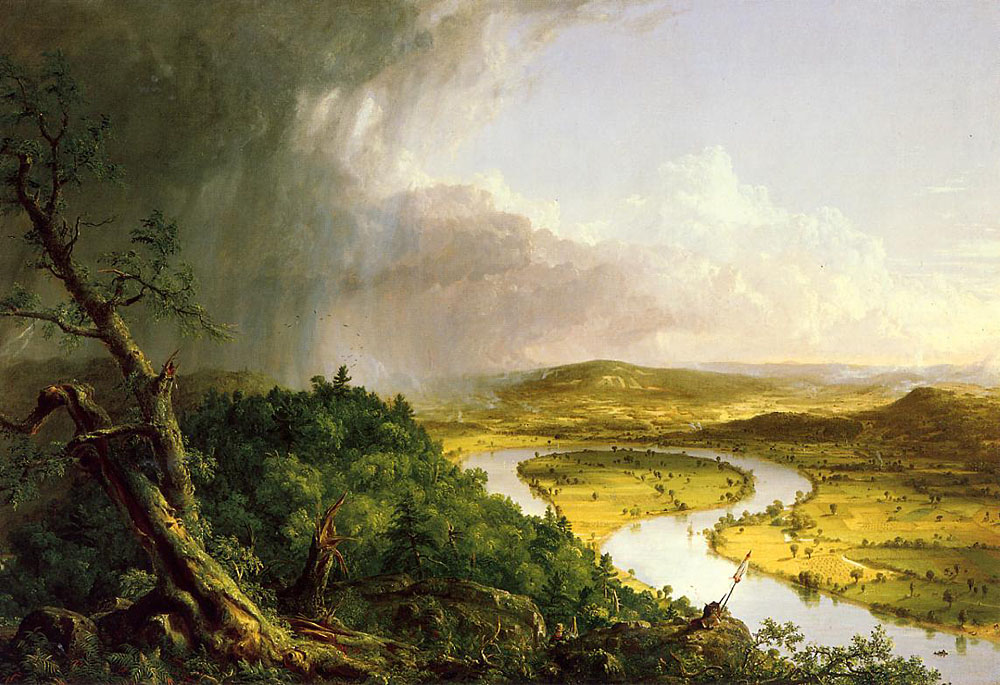- The Oxbow
Infobox Painting|

title=The Oxbow
artist=Thomas Cole
year=1836
type=
height=130.8
width=193
height_inch=51 1/2
width_inch=76
city=New York
museum=The Metropolitan Museum of Art "View from Mount Holyoke, Northampton, Massachusetts, after a Thunderstorm", commonly known as "The Oxbow", is a
painting byThomas Cole .Background
Starting from the fall of 1835 and into the winter and early months of 1836, Cole had been hard at work on his series of paintings "
The Course of Empire ". The work was commissioned by New York patronLuman Reed , who had met Cole in 1832, and the two held a friendship largely based on Reed's generosity in buying Cole's paintings. Reed requested "The Course of Empire" to comprise no less than five paintings of a historic composition. Cole himself was excited by such a project, but doubt began to set in by the end of 1835. The work was slow and laborious, and Cole found great difficulty in painting the figures. Reed had begun to notice Cole was becoming lonely and depressed, and suggested that he suspend work on "The Course of Empire" and paint something that was more in his element for the April 1836 opening of theNational Academy of Design 's annual exhibition. Cole, in replying to Reed in a letter, stated that he felt obliged to finish the series as Reed had been so generous in his support, and instead suggested that he simply complete the last painting in the series and display that at the exhibition. Reed however, did not really like the idea, as he thought it might spoil the unveiling of the series as a whole. He suggested instead that he paint a picture much like the already completed second painting in the series, "The Pastoral State". This depicted a peaceful setting which Reed thought "no man ever produced a more pleasing landscape in a more pleasing season." Responding in a letter in March of 1836, Cole agreed to take Reed's advice and paint a picture for the exhibition, writing:Roque, Oswaldo Rodriguez (1982). "The Oxbow" by Thomas Cole: Iconography of an American Landscape Painting". Metropolitan Museum Journal. pp. 63-7.]
Cole also comments that he used a larger canvas, as he was not able to ready a smaller frame in time for the exhibition, and moreover felt compelled to make a statement with the one painting he was to present.Fancy pictures seldom sell & they generally take more time than views so I have determined to paint one of the latter. I have already commenced a view from Mt. Holyoke—it is about the finest scene I have in my sketchbook & is well known—it will be novel and I think effective—I could not find a subject very similar to your second picture & time would not allow me to invent one.Composition
The painting moves from a dark wilderness with shattered tree trunks on rugged cliffs in the foreground covered with violent rainclouds on the left to a light-filled and peaceful, cultivated landscape on the right, which borders the tranquility of the bending
Connecticut River . In returning to painting landscapes, Cole was faced with the dichotomy of the untamed wilderness and land cultivated by man. While other painters of theHudson River School would merge the two peacefully, Cole did not shy away from portraying the two as opposites and showing how the cultivation would destroy the natural wilderness, and as a result never meet in the painting. [Flexner, James T (1998). "Random Harvest". Fordham University Press. p. 145. ISBN 0823217310.] On the hill in the far background, logging scars in the forest can be observed, which appear to form Hebrew letters. This was first noticed by Matthew Baigell long after the landscape was painted. If viewed upside down, as if from God's perspective, the word "shaddai" is formed, "The Almighty." Cole gives himself a tinyself-portrait sitting on the rocks in the foreground with his easel. [Wilmerding, John (2003). "Signs of the Artist: Signatures and Self-expression in American Paintings". Yale University Press. p. 58. ISBN 0300097794.]Ownership
Cole sold the painting at the exhibition to Charles Nicoll Talbot (1802-1874), merchant in the China trade. [David Bjelajac, "Thomas Cole's "Oxbow" and the American Zion Divided", "American Art" 20 (2006), pp60–83.] In 1838 he lent it to the Dunlap Benefit Exhibition, and later to the third annual exhibition of the Artists' Fund Society, which was held in New York in 1862. With his death in 1874, the painting was acquired from his estate by
Margaret Olivia Slocum Sage , wife ofRussell Sage . Olivia Sage was a known philanthropist, and her transfer of "The Oxbow" to theMetropolitan Museum of Art in 1908 would seem rather natural. However, she may have been inspired by a similar gesture in 1904 by Samuel P. Avery, Jr., who donated "The Titan's Goblet ", another of Cole's well-known paintings, to the Metropolitan Museum of Art. Furthermore, it should be noted that Olivia Sage's attorney, Robert de Forest, was a secretary on the Board of Trustees of the Metropolitan Museum. The painting today resides in The Metropolitan Museum of Art. [Parry III, Ellwood C (2003). "Overlooking the Oxbow: Thomas Cole's "View from Mount Holyoke" Revisited". American Art Journal. Volume 34, pp. 6-61.]External links
* [http://www.metmuseum.org/Works_of_Art/recent_acquisitions/2000/co_rec_n_america_2001.153.asp "The Oxbow: After Church, after Cole, Flooded; Stephen Hannock (American, b. 1951)"] at
The Metropolitan Museum of Art Notes
reflist
Wikimedia Foundation. 2010.
